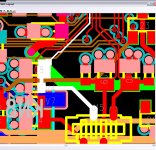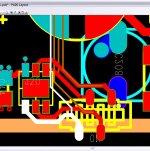My subject is hardly audio, purely industrial electronics but I know there skilled guys out there who maybe have experience in this.
I'm using a 4-wire touch panel in a product where people push the panel in a certain area, maybe 1000 times a day. This panel has lasted for years. In other words acceptable lifetime. Some year back we changed brand and have used several brands and everyone of them are not particularly good. From a couple months to a year maybe in lifetime. The thing is that we have tested the original brand also but we are 100% sure of if the product is 100% the same as before. The original isn't good either.
What happens? Resistive coating is 900 ohms in Y and 300 ohms in X. A soft pressure creates 1 kohms in contact resistance between X and Y. The defective area requires more pressure to achieve the same resistance and in severe cases the resistance will decrease to 10-100 kohms and even a couple of Mohms.
It's obvoius that the panel wears out but why?
The panel is connected directly to a ARM EP9307 Cirrus with built-in touch panel controller.
The old pcb had 22 pF//AVX VC060326A580 (ceramic voltage surpressor) from electrode to ground, each connection. This pcb used only the original touch panel.
The new pcb has Maxim Max3204 connected between 3.3V and GND.
The problems started with the new pcb AND new panels but also with the same brand as before but with possibly not the same quality.
An idea is ESD wearout perhaps. Any ideas?
(Excuse me for the long post)
I'm using a 4-wire touch panel in a product where people push the panel in a certain area, maybe 1000 times a day. This panel has lasted for years. In other words acceptable lifetime. Some year back we changed brand and have used several brands and everyone of them are not particularly good. From a couple months to a year maybe in lifetime. The thing is that we have tested the original brand also but we are 100% sure of if the product is 100% the same as before. The original isn't good either.
What happens? Resistive coating is 900 ohms in Y and 300 ohms in X. A soft pressure creates 1 kohms in contact resistance between X and Y. The defective area requires more pressure to achieve the same resistance and in severe cases the resistance will decrease to 10-100 kohms and even a couple of Mohms.
It's obvoius that the panel wears out but why?
The panel is connected directly to a ARM EP9307 Cirrus with built-in touch panel controller.
The old pcb had 22 pF//AVX VC060326A580 (ceramic voltage surpressor) from electrode to ground, each connection. This pcb used only the original touch panel.
The new pcb has Maxim Max3204 connected between 3.3V and GND.
The problems started with the new pcb AND new panels but also with the same brand as before but with possibly not the same quality.
An idea is ESD wearout perhaps. Any ideas?
(Excuse me for the long post)
Anything that flexes is probably prone to fatigue fractures. You bend a wire enough times it breaks. Maybe you have tiny stress fractures.
Why the new panel breaks quicker than the old? Who knows? Maybe a slight change in conductor alloy?
Alternatively, could be oxidisation or other chemical decomposition of mating surfaces. Perhaps the original panel had a better gastight seal? (just lucky) Is there any contaminant in the atmosphere?
You can get dedicated single-chip capacitive touch sensors now, or use a Microchip PIC, Some will scan multiple buttons. Maybe you could build a replacement with no moving parts?
w
Why the new panel breaks quicker than the old? Who knows? Maybe a slight change in conductor alloy?
Alternatively, could be oxidisation or other chemical decomposition of mating surfaces. Perhaps the original panel had a better gastight seal? (just lucky) Is there any contaminant in the atmosphere?
You can get dedicated single-chip capacitive touch sensors now, or use a Microchip PIC, Some will scan multiple buttons. Maybe you could build a replacement with no moving parts?
w
I used to run a company making these pads. Yes, the resistive material can wear out, especially if it's not thoroughly cured or the ink uses a softer resin for a vehicle. Best materials for wear were two-part epoxies (we sourced those from Acheson) or phenoxy resins (we got those from DuPont).
One other possible issue is the print treatment of the backing film (usually Mylar or something similar), when the surface energy isn't quite high enough.
Transparent pads usually use ITO; the lifetime and integrity is almost always dependent on the control of the CVD or sputtering process used to coat the films.
HTH.
One other possible issue is the print treatment of the backing film (usually Mylar or something similar), when the surface energy isn't quite high enough.
Transparent pads usually use ITO; the lifetime and integrity is almost always dependent on the control of the CVD or sputtering process used to coat the films.
HTH.
I have cut the polyester film into stripes and the resistive layer is intact. No sign of wear out. All small stripes have the same resistance.
A theory is that the plastic film has worn out plastic dots and possibly the film has gotten a coating (some kind of pollution) with not so good electrical properties. The plastic dots may contain something which is leaked out.
My gut feeling is that the ESD protection is part of the problem. A possible fix is to patch in an ESD protection similar as before or even more.
A theory is that the plastic film has worn out plastic dots and possibly the film has gotten a coating (some kind of pollution) with not so good electrical properties. The plastic dots may contain something which is leaked out.
My gut feeling is that the ESD protection is part of the problem. A possible fix is to patch in an ESD protection similar as before or even more.
- Status
- This old topic is closed. If you want to reopen this topic, contact a moderator using the "Report Post" button.
- Home
- General Interest
- Everything Else
- Resistive touch panel wareout

